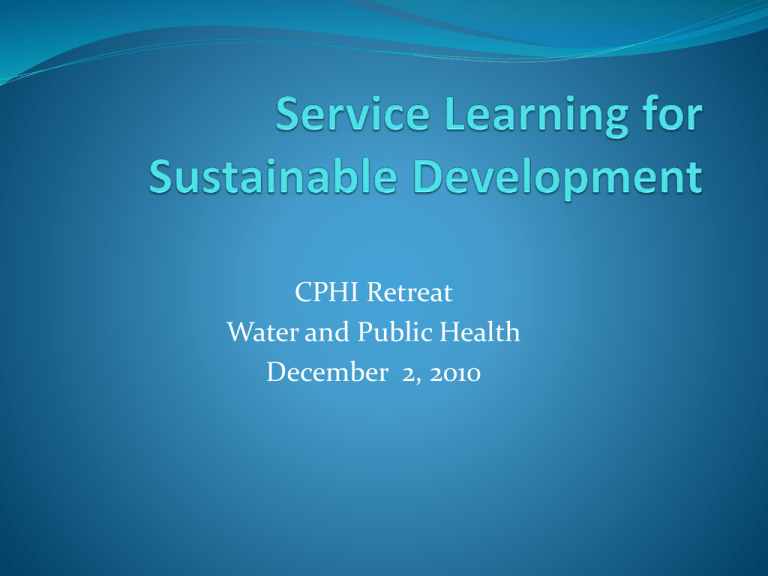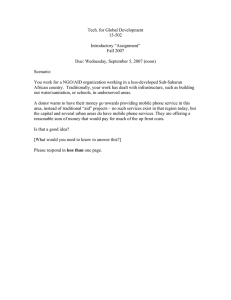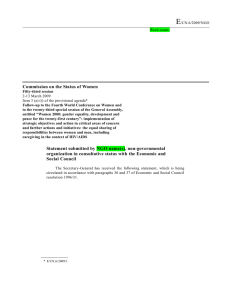CPHI Retreat Water and Public Health December 2, 2010
advertisement

CPHI Retreat Water and Public Health December 2, 2010 Community Impact: Global Water Crisis 1.1 billion people worldwide have inadequate access to clean water 2.6 billion people worldwide have inadequate access to sanitation 1.8 million child deaths occur each year as a result of diarrhea Opportunities Communities in developing countries benefit from shared resources beyond their borders Students from the U.S. benefit from global engagement in a cross cultural setting Different Goals Primary goal for community is to improve health with a sustainable water and sanitation system Primary goal for students and the sponsoring academic institution is a global education How can these goals be achieved with a positive outcome for everyone involved? Water supply more amenable to merging goals than other community development projects What’s Needed? - Initially Request for assistance from an established NGO working in community Proposed project small enough in scale Community willing to contribute their own resources What’s Needed? - Preparation Preparation and Groundwork for Community and students before implementation: Assessment trip to understand design constraints and begin relationship Preparation of a Memo of Understanding outlining roles and commitments Community needs to organize its leadership and resources for long term sustainability Students need to participate in design and learn about cultural context in a course What’s Needed? - Implementation NGO critical Students need to be hosted in community Daily communication at all stages Sharing of technical design attributes What’s Needed? – Follow-up Community needs technical oversight from NGO’s representative in communication with Mentor/student team to complete project Students need to provide feedback on their experience and the opportunity to learn on impact of design Should be independent evaluation of project after complete and operating. Mission & Objectives Mission: Improve the quality of life for individuals and communities in the developing world through sustainable technology and engineering, and through engaging students in learning about and service to civil society. Program Objectives: 1. Teach students about the challenges in the developing world and the role that appropriate technology and sustainable engineering plays in this setting. 2. Work closely with local communities to responsibly provide useful technical solutions to individuals and communities in the developing world. Organization SEAS Community Technology and Outreach Initiatives “office” Local initiatives Global initiatives Departmental and faculty involvement Teaching Leading field projects Student organizations Integral to the learning and projects model Student leadership experiences Oversight and administration SEAS Office of Academic Programs/Associate Dean Faculty Advisory Committee Director Staff Projects Clean water delivery & sanitation systems Honduras 2006-present Cameroon 2007-present India 2009-present Guatemala 2009-present Problem Solving/Learning EAS 296 - Sustainable Development in Cameroon • EAS 297 Sustainable Development: Technology for Water & Sanitation Classroom Preparation - Engineering Engineering for Rural Water and Sanitation Water demand and supply; Public health Spring Development and Protection Engineering for Sustainable Development Appropriate Technology in International Development Practical Field Engineering Classroom Preparation - Cameroon Orientation Presentation by Travel Medicine Review of Cameroon history and culture with focus on Kob- Tudig region Meta language Team work in cross-cultural setting Academic Deliverables Homeworks System Design On-the-ground experience Daily journal Capstone Project Community Impact Infrastructure Education Health and Livelihood - Dramatic increase in clean water availability - Perceivably decreased soil erosion and increased quality of environment - Improved communication capabilities and access to information - Increased access to information and educational resources - Inspired greater desire to complete education and to advance to senior secondary schooling and beyond - Reduced incidence of waterborne diseases in the community - Reduced time used for water hauling, increasing time available for productive tasks - Increased individuals’ ambulatory ability leading to happier and more productive living Key factors to success Strong NGO Guidance and clear leadership of project mentors Committed community. But how to gauge that from the beginning? Long-term commitment to community, NGO Ability, willingness to revise project tracking methodology on-the-fly Conclusions Community and students have an exciting, sometimes life-changing exchange – many say time too short Sustainable projects are possible but there is a risk of failure if NGO is not able to cover for the time student/mentor team is not present Academic institution needs to have a long-term program both for students and communities


